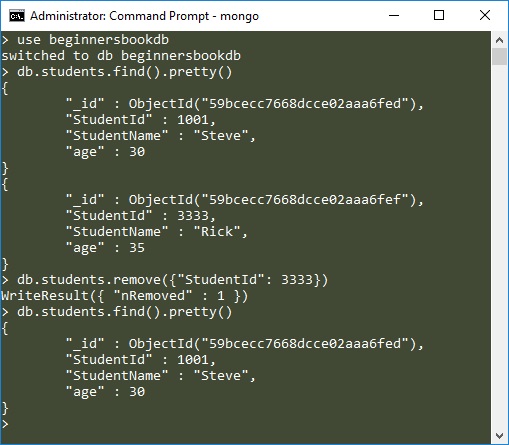

- #DELETE ALL DOCUMENTS IN COLLECTION MONGODB COMPASS HOW TO#
- #DELETE ALL DOCUMENTS IN COLLECTION MONGODB COMPASS FULL VERSION#
- #DELETE ALL DOCUMENTS IN COLLECTION MONGODB COMPASS INSTALL#
- #DELETE ALL DOCUMENTS IN COLLECTION MONGODB COMPASS DOWNLOAD#
You can add values as JSON or key-value pairs in this Helper window.Īlthough you can insert more documents in the same way as we just discussed, we can speed it up with the Clone operation. A Helper window will pop up to insert documents. In order to add data manually, click on the second option of the Add Data dropdown. Browse and upload the file there, then tick the relevant file type and click import. When you click it, a new window will open in which you can upload the file. The first option allows you to import data as a JSON or CSV file. Here you can find the Add Data drop-down that provides you two ways to insert data: Next, click on the collection name, Students, which you created earlier, and Compass will display a new screen, like this: Locate the cursor on the School database from the left side pane of Compass and click on it.
#DELETE ALL DOCUMENTS IN COLLECTION MONGODB COMPASS HOW TO#
Let’s see how to add documents to our newly created database. Each record in a MongoDB database is a document. In MongoDB, data is inserted as documents. (Want to use the mongo shell instead of the Compass GUI? Learn how to create a database that way.) Creating documents The newly created database will appear in the dashboard, as shown below. Enter a Collection name (e.g., Students).A new window will pop up, as shown below: You can see a list of databases available in the server and a set of options that you can use to create and delete databases:Ĭreating databases, collections, and inserting dataĬlick the CREATE DATABASE option to create a new database. Now, you are connected to your MongoDB server. If you installed MongoDB on your machine with default settings, the Hostname would be the localhost, and the port is 27017. Specify the Hostname and the port in which your MongoDB server is running. Connecting to a databaseįirst, open your MongoDB Compass application and click the Fill in connection fields individually option.
#DELETE ALL DOCUMENTS IN COLLECTION MONGODB COMPASS DOWNLOAD#
Once you download the relevant package, run the installer, and follow the steps that come after it. MongoDB supports all the main operating systems, such as:ĭownload the packages you want here.
#DELETE ALL DOCUMENTS IN COLLECTION MONGODB COMPASS INSTALL#
Most of the time, it’s the full edition that you need, so that’s what we’ll install in this tutorial. Compass Isolated does not involve any requests for the network.You won’t have the capability to edit, write, or delete. Compass Read-Only is limited to the read operations.Compass has the full capabilities and features of MongoDB Compass.It’s important to note that MongoDB Compass comes in three editions: It’s free to use for everyone and will make working with MongoDB easier than any other tool.
#DELETE ALL DOCUMENTS IN COLLECTION MONGODB COMPASS FULL VERSION#
You can enjoy the benefits of MongoDB’s powerful features by installing the full version of Compass.




 0 kommentar(er)
0 kommentar(er)
